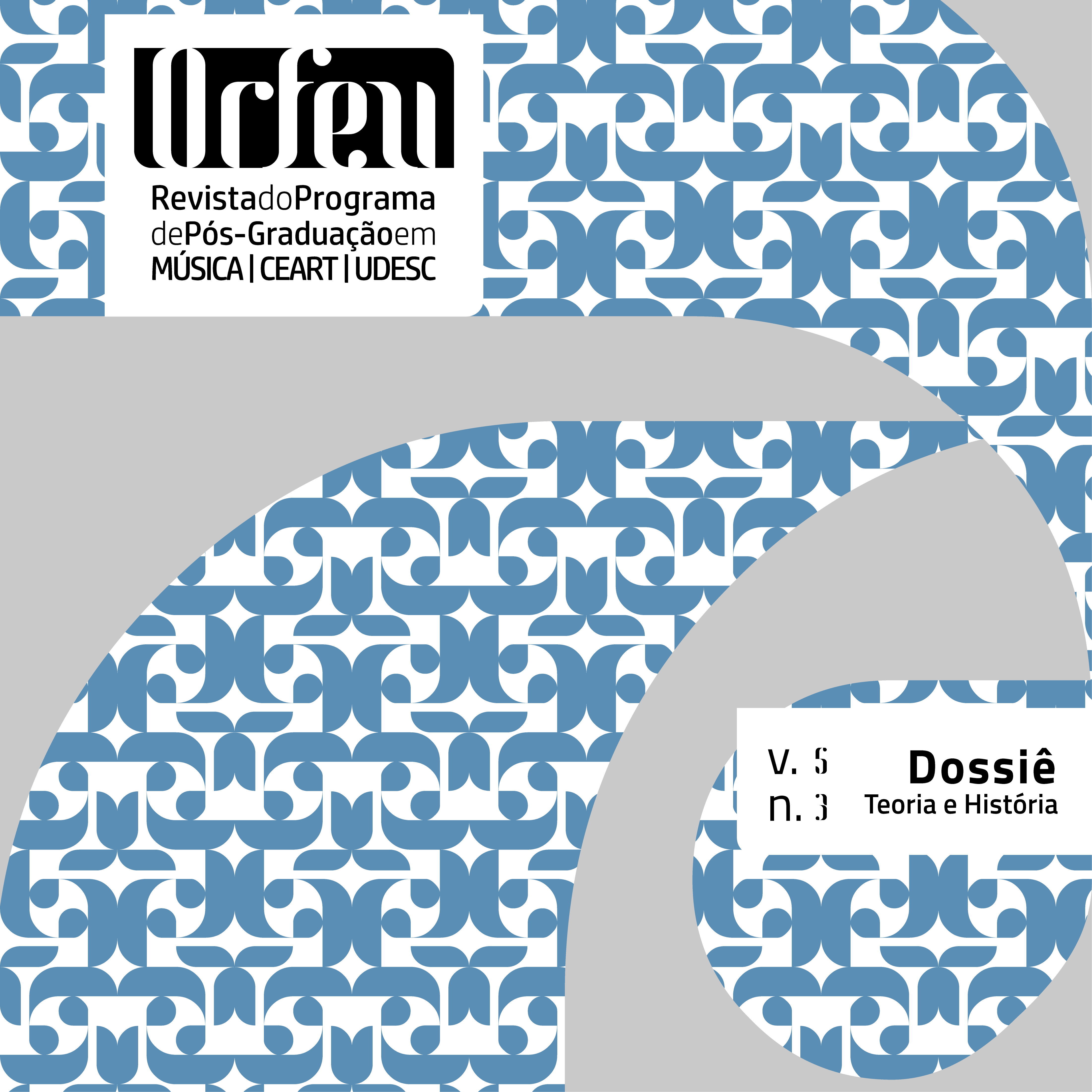Sinfonia nº 4 de Villa-Lobos: a vitória, a derrota e a volta por cima
DOI:
https://doi.org/10.5965/2525530405032020341Parole chiave:
Villa-Lobos, Sinfonia, Narratividade, Teoria das tópicas, Análise musicalAbstract
O propósito deste trabalho é apresentar uma análise da Sinfonia no 4 (“A Vitória”) de Heitor Villa-Lobos (1887-1959) a partir de sua estrutura formal e narrativa. A obra foi composta em 1919 para celebrar o final da primeira guerra mundial, e sua estreia foi programada para um concerto dedicado ao casal real belga que visitava o Brasil em 1920.
Originalmente estruturada como um poema sinfônico em três partes, a obra se baseia em texto escrito por Luís Gastão d’Escragnolle Dória (1869-1948). A narrativa literária é recoberta por outra, de caráter musical, estruturada em forma cíclica segundo o método de Vincent d’Indy. A análise irá buscar pontos de aproximação e afastamento entre as narrativas literária e musical, segundo teorias de narratividade propostas por Eero Tarasti (1994) e Byron Almén (2008), além de análises tópicas, segundo Leonard Ratner (1980), Wye Allanbrook (1983), Raymond Monelle (2000; 2006) e outros. O objetivo é interpretar os aspectos musicalmente significativos resultantes da intertextualidade entre música e texto.
Downloads
Riferimenti bibliografici
ALLANBROOK, Wye J. Rhythmic Gestures in Mozart: Le Nozze di Figaro and Don Giovanni.
ALMÉN, Byron. A Theory of Musical Narrative. Bloomington, IN: Indiana University Press, 2008.
BOULEZ, Pierre. A música hoje 2. Tradução de Geraldo G. de Souza. São Paulo: Perspectiva, 1992 [1985].
CAPLIN, William. Classical Form: A Theory of Formal Functions for the Instrumental Music of Haydn, Mozart, and Beethoven. New York; Oxford: Oxford University Press, 1998.
CORREIO DA MANHÃ. Morreu o autor dos ‘Pingos e Respingos’: com o falecimento de Bastos Tigre perdem as nossas letras o último humorista sério do Brasil. Rio de Janeiro: 3 ago. 1957. Disponível em: http://memoria.bn.br/DocReader/Hotpage/HotpageBN.aspx?bib=089842_06&pagfis=79742&url=http://memoria.bn.br/docreader#. Acesso em 14 fev. 2020.
CORREIO DA MANHÃ. A ópera Izaht de Villa-Lobos. Rio de Janeiro, 10 jun. 1921. Disponível em: http://memoria.bn.br/DocReader/Hotpage/HotpageBN.aspx?bib=089842_03&pagfis=6512&url=http://memoria.bn.br/docreader#. Acesso em 22 fev. 2020.
DÓRIA, Luís G. d’Escragnolle. A Victoria. In: Jornal do Commercio, Rio de Janeiro, 31 jul. 1919. Acesso em 15 nov. 2019. Disponível em: http://memoria.bn.br/docreader/DocReader.aspx?bib=364568_10&pagfis=42505.
ENYART, John W. The Symphonies of Heitor Villa-Lobos. Dissertation for the degree of Doctor of Philosophy in Music, University of Cincinnati, 1984.
FAGUNDES, Luciana P. A recepção do Embaixador da Paz: um concerto de gala para Epitácio Pessoa. Revista Brasileira de Música, Rio de Janeiro, v. 31, n. 1, p. 163-186, 2018.
FAGUNDES, Luciana P. Uma República em festa: a visita dos reis belgas ao Brasil (1920). Dissertação de Mestrado em História Social. Rio de Janeiro: Universidade Federal do Rio de Janeiro, Instituto de Filosofia e Ciências Sociais, 2007, p. 177-180.
GAMA, Zadig M. F.; MELLO, Celina Maria M. de. Luís Gastão d’Escragnolle Dória: um polígrafo das letras brasileiras. Soletras, Dossiê n. 34, p. 329-353, 2017. DOI: 10.12957.
GUÉRIOS, Paulo. Heitor Villa-Lobos: o caminho sinuoso da predestinação. 2. ed. Curitiba: Edição do autor, 2009.
GUIMARÃES, Luiz et al. Villa-Lobos: visto da plateia e na intimidade (1912/1935). Rio de Janeiro: Arte Moderna, 1972.
GREIMAS, Algirdas J. Sobre o sentido II: ensaios semióticos. Tradução de Dilson F. da Cruz. São Paulo: Nankin; Edusp, 2014 [1980].
HEPOKOSKI, James; DARCY, Warren. Elements of Sonata Theory: Norms, Types, and Deformations in the Late-Eighteenth-Century Sonata. Oxford; New York: Oxford University Press, 2006.
D’INDY, Vincent. Cours de composition musicale. Paris: Durand, 1909.
KATER, Carlos. Villa-Lobos de Rubinstein. Latin American Music Review, v. 8 n. 2, p. 246-253, 1987.
MARIZ, Vasco. Heitor Villa-Lobos, compositor brasileiro. 11. ed. Belo Horizonte: Itatiaia, 1989.
MIGALHAS. Homenagem a Manoel Bastos Tigre. ISSN 1983-392X. Endereço eletrônico: https://www.migalhas.com.br/quentes/188672/homenagem-a-manoel-bastos-tigre. 21 out. 2013. Acesso em 14 fev. 2020.
MONELLE, Raymond. The Musical Topic: Hunt, Military, and Pastoral. Bloomington, IN: Indiana University Press, 2006.
MONELLE, Raymond. The sense of Music. Princeton and Oxford: Princeton University Press, 2000.
MOORTELE, Steven Vande. Two-Dimensional Sonata Form: Form and Cycle in Single-Movement Works by Liszt, Strauss, Schoenberg, and Zemlinsky. Leuven: Leuven University Press, 2009.
RATNER, Leonard. Classic Music: Expression, Form, and Style. New York: Schirmer, 1980.
SALLES, Paulo de Tarso. Os quartetos de cordas de Villa-Lobos: forma e função. São Paulo: Edusp, 2018.
SALLES, Paulo de Tarso. Villa-Lobos, processos composicionais. Campinas: Ed. Unicamp, 2009.
STOÏANOVA, Ivanka. Manuel d’analyse musicale: variations, sonate, formes cycliques. Paris: Minerve, 2000.
TARASTI, Eero. A Theory of Musical Semiotics. Bloomington, IN: Indiana University Press, 1994.
WHEELDON, Marianne. Debussy and La Sonate Cyclique. The Journal of Musicology, v. 22, n. 4, p. 644-679, 2005.
Downloads
Pubblicato
Come citare
Fascicolo
Sezione
Licenza
Copyright (c) 2020 ORFEU

TQuesto lavoro è fornito con la licenza Creative Commons Attribuzione 4.0 Internazionale.






